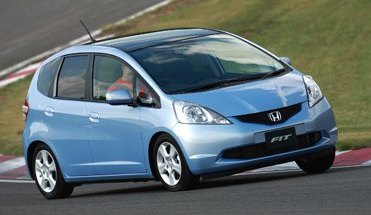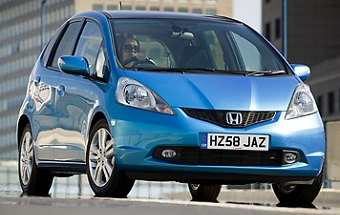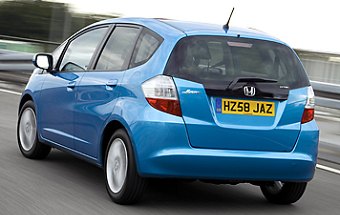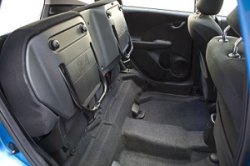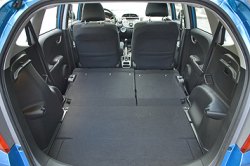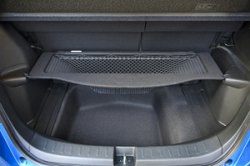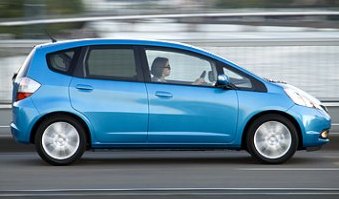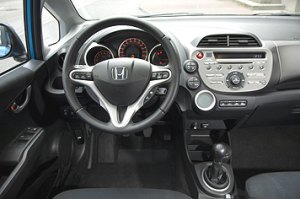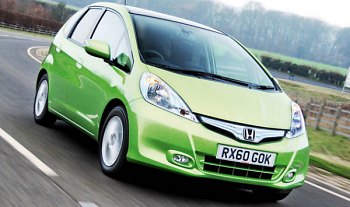Honda Fit / Jazz
Debut: 2008 |
|||||||||||
The first generation Honda Fit was born in late 2001 and became a runaway success. It was renowned for a clever packaging that maximized interior space out of a small exterior and a flexible seating / luggage-loading arrangement. Its success extended to Europe and even United States, where it is called Jazz. More than 2 million units of Fit and Jazz were sold worldwide until the Mk2 arrived in late 2007. Overseas market waited a further three quarters to get their hands on the new car. Unfortunately, by that time Ford had introduced its ground-breaking new Fiesta. Can the pearl of the east beat the jewel of the west ? We shall see… The new Fit / Jazz has grown a little bit – compare to the old car it is 55 mm longer and 20 mm wider, although the 1525 mm height (which is tall by class standard) is unchanged. Wheelbase has been stretched by 50 mm to a total of 2500 mm. It is about the same size as Mazda 2 thus is smaller than European rivals like Renault Clio, Peugeot 207 and Fiat Grande Punto. It is also a little shorter and narrower than the new Fiesta. However, none of these cars could match its interior volume. Its windscreen has been pushed further forward and steeply angled so that it becomes a monospace. Larger window area makes it look smarter and lighter. Style has been enhanced by sharper design of headlamps and front intakes, while a sudden drop in the roof line behind the rear door is a strange new feature. Front quarter windows have been added to reduce blindspots.
Benefiting from a larger windscreen and full-length panoramic glass roof, the cabin feels more airy than ever. Visibility is great all round, a rare achievement these days. We must praise the thoughtful features Honda built into this little car. Although the dashboard design is far from classy, the trim is plain dark and it employs far more hard plastics than European counterparts, its ergonomics and features are hard to fault. All frequently used controls and switches are placed at the upper half of the dash and console for easy reach. All controls, no matter steering, clutch and gearshift, have a light and easy going manner. There are plenty of storage cubbies in the cabin and as many as 10 cupholders so that you can make your own cocktail while traveling. Two things mark it out from the crowd: space and versatility. The Fit / Jazz can really take four big guys for long journey (five would be a squeeze because of its limited width anyway). The longer wheelbase gives rear passengers 40 mm extra knee room. In addition to a tall roof, rear passengers must love this car more than its European rivals. As for luggage space, it is simply in a class of its own. Like the Mk1, the new Fit / Jazz has its fuel tank located under the front seats so to leave space underneath the rear seats for the sake of versatility. If you want to carry a tall item, e.g. a small Christmas tree, you can flip up the rear seat cushion and put the tall item on the rear floor. Alternatively, by one action you can fold and drop the rear bench onto the floor to reveal a flat yet low cargo loading area, which could swallow as much as 883 liters. Even with all seats in place, its boot still measures a class-leading 399 liters. Moreover, the hatchback door is large and the load sill is low, very convenient to use. The boot has a flexible parcel shelf and an additional storage area under the boot floor to store tiny items… Oh my God ! Is this a supermini or a van ?
Okay, we are actually not too concerned about luggage space. What we care most is how good it drives and how great it feels, so let’s concentrate back on the mechanical aspects. The new Fit / Jazz still follows the format set by its predecessor. This mean it rides on suspensions consisting of struts up front and torsion beam axle at the rear, although the bushings and fine tuning have been improved. Electrically assisted steering continues to serve the car. The chassis is 160 percent stiffer than the old one, thanks to higher percentage of high-strength steel used and other structural reinforcement. Although Honda said weight saving measures limited its weight increase to merely 10 kg, a comparison between the old and new spec. will find it is actually 30-70 kilograms heavier engine by engine. This make it slightly heavier than the new Fiesta too. In the engine compartment, you will find either a 1.3-liter SOHC i-VTEC or 1.5-liter SOHC i-VTEC engine. Honda is playing with the label “i-VTEC”. In these two engines, it means the conventional two-stage intake cam profile-switching VTEC mechanism without variable cam-phasing. In the 1.3 engine, the low speed cam simply shuts down one of the intake valves in each cylinder, so it effectively becomes a 3-valve-per-cylinder engine. The purpose is to create swirl in the combustion chamber to help mixing fuel and air. At higher rev, the 1.3 engine works as a 16-valve engine to produce 100 horsepower at 6000 rpm. The 1.5-liter engine has a normal fast/slow cam VTEC mechanism to enable 120 horsepower at 6600 rpm. It sounds on a par with Fiesta’s 1.6 Ti-VCT engine, but it delivers less torque and requires some 4800 rpm to reach the maximum. Both engines are major on smoothness and frugality rather than performance.
The standard transmission is a 5-speed manual with Honda’s typical slick gearchange. Japanese customers may specify a CVT with 7-speed manual override (carried over from Mk1) while overseas customers are offered with a 6-speed automated manual. Both are not responsive enough to attract keen drivers. On the road, the new Fit / Jazz displays adequate handling and ride. While the old car suffered from a stiff ride, the new car has a smoother ride and slightly better body control thanks to its stiffer chassis, longer wheelbase and wider stance. However, it is not as well insulated against noise as Fiesta and other European rivals – admittedly, a spacious package always compromises insulation and requires more sound deadening materials. On winding roads, its i-VTEC engines need to be kept at above 4500 rpm to deliver sufficient punch. This deteriorates its refinement too. The tall car generates more understeer in corners and isn’t as tightly controlled as its European rivals. Moreover, its electrical power steering remains light and numb as the Mk1. As a result, the Honda is not as much fun to drive as Fiesta, Corsa, Punto or Mazda 2. Its dynamics is not bad, but you should look elsewhere if dynamics is your first priority. However, the majority of customers might have different conclusions. They will be attracted by its spacious interior, clever luggage layout, smooth and easy driving manner, excellent fuel economy and dependable reliability. These areas are what Ford Fiesta fails to match. On the downside, it can’t match the style, cabin quality, refinement and handling of the Fiesta. It’s up to you to decide which one fits you best. |
|||||||||||
| The above report was last updated on 30 Sep 2008. All Rights Reserved. |
| Specifications | ||||||||||||||||||||||||||||||||||||||||||||||||||||||||||||||||||||||||||||||||||||||||
|
||||||||||||||||||||||||||||||||||||||||||||||||||||||||||||||||||||||||||||||||||||||||
| Performance tested by: *Autocar, **C&D |
Copyright©
1997-2011
by Mark Wan @ AutoZine
